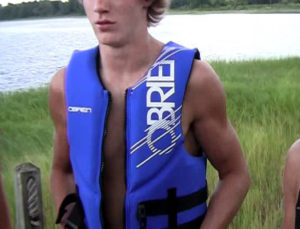 Even if you are not a fisher, if you spend at least some time on the water, a life jacket is a vital necessity. Accidents happen, and even if you can swim, a life jacket is not something that should be neglected. The shock of falling into the water can easily overwhelm a person and stop them from using their skills. In fact, children must wear personal floatation devices on board at all times, although the legal requirements differ somewhat from state to state.
Even if you are not a fisher, if you spend at least some time on the water, a life jacket is a vital necessity. Accidents happen, and even if you can swim, a life jacket is not something that should be neglected. The shock of falling into the water can easily overwhelm a person and stop them from using their skills. In fact, children must wear personal floatation devices on board at all times, although the legal requirements differ somewhat from state to state.
But life jackets and PFDs are not the same things. It’s all too easy to mix up life jackets as such and personal flotation devices, but they are somewhat different.
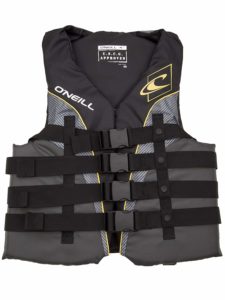
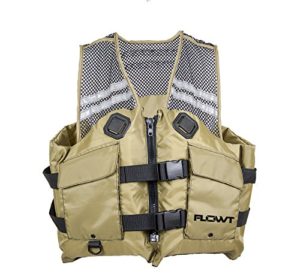
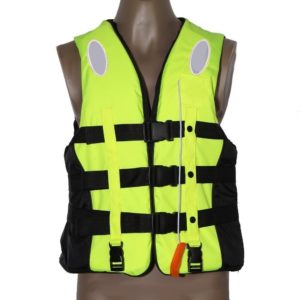

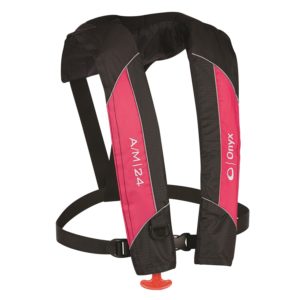
Top 5 Best Life Jackets in 2019
1O'Neill Men's Superlite USCG Life Vest — Best Bang for the Buck
Even from the name alone, you can tell that this life jacket meets all USCG criteria, but that’s hardly everything it can boast.
First, about some of the disadvantages. The worst one, in my opinion, is the color. While not precisely camo, this life jacket is way too dark, it should be quite hard to notice in the dark. But then again, it wasn’t designed for fishing, it’s a recreational life jacket first.
It’s meant to be used in a lifeguard controlled area, where people usually do watersports, waterskiing and the like.
It’s still not too dark and should not impossible to notice in the day time, but it’s not a high-visibility life jacket by any stretch.
The vest is apparently too snug, and I recommend ordering it a size up, and also recommend that you read the customer reviews. Perhaps, some of those who bought this vest have a body built similar to yours.
The life jacket has a polyester shell, and that’s more than enough to protect the jacket from damages. Not that it matters a lot, after all, it’s a foam vest. That, of course, means that it’s a little bulky to wear. But on the other hand, you don’t have to rely on some failsafe mechanism or staying conscious to be able to inflate it, it’s already float-ready as it is. And it’s not too bulky, no to the extent many other foam life jackets are.
- Lightweight and buoyant. The polyurethane foam inside is very light, which adds to the buoyancy.
- 100% polyester shell. While polyester is denser than water, it's waterproof and hydrophobic.
- Ready for use at all times. By being a foam jacket, this vest is always ready to save your life. Nothing there to malfu
- Not as bulky as other foam vests. The foam tends to take up a lot of space, but thanks to the how large the vest is, all that foam is spread evenly.nction.
- Dark colors. The vest is hard to notice in the dark
- No whistle. The vest doesn’t have a whistle included.
2Flowt 40626 Mesh Fishing Adult Life Vest — Best Overall
Another foam Type III vest that you’re going to enjoy wearing when fishing. It’s not really a high-visibility jacket, but it’s pretty light, and it has reflective mesh shoulder straps, which makes it pretty safe for use in the dark. Not only does it help in rescuing the wearer should the need for that come, but the wearer also becomes highly visible at sunset and sunrise, when it’s hard to make out a sitting human silhouette from a larger vessel. In a sense, it can also prevent a boat from a collision. Not that you shouldn’t have navigation lights onboard to avoid the exact same thing from happening.
You will hardly ever feel you’re wearing it, and that’s not something every life jacket can boast.
Since it is positioned as a fishing life jacket, it comes with 2 pockets where you can keep your tackle. I also advise that you put a whistle in there since this life vest comes without one. In fact, I recommend stuffing one pocket with things useful for survival (chem-lights and a whistle if you’re in a highly crowded area, fresh, clean water if you sail away from shore and other people), and reserve the other one for the tackle.
- Lightweight and buoyant. For a seemingly small vest, it is surprisingly floatable.
- Feels pretty flat. It’s anything but bulky, and it’s great that it is.
- Ready for use at all times. Much like every other foam life jacket, this one is ready for any situation life throws at it.
- Dedicated vest for fishing. Aside from all the other pros, its primary intended use is fishing. It comes with two pockets, perfect for keeping tackle there.
- No whistle. For all its advantages, the vest does not include a whistle. You need to buy that separately.
- Only 2 security straps. While it's nice that those straps are there, the more, the better.
3Tbest Children and Adult Life Jacket — Safest Type III Vest for Fishing
It’s probably the safest life jacket of this type. It’s still a Type 3, but it’s a high-vis vest that comes with a whistle and, what’s more important, two crotch traps. Now that is a life jacket that’s not coming off, no matter what you do, other than unfastening all the webs.
Saying this life jacket is highly buoyant isn’t serving it any justice. The largest size can bear up to 240 pounds. That’s enough to keep even an overweight grown man afloat. Some of the sizes are meant for children.
In addition to the easy to spot coloring, the vest has limous straps on the shoulders, to increase the visibility in the dark further.
- Highly buoyant. The vest can bear a fully grown man without a single problem
- Not bulky. Unlike many safety-first life jackets, this one manages to be less bulky.
- Ready for use at all times. You probably expected that, seeing how it’s made of foam.
- Included whistle. Even if you remain unnoticed for some strange reason, you can attract attention.
- Crotch straps. This a vest that once on, stays on.
- High visibility vest. It’s super easy to spot, which can be crucial for a target of a search and rescue operation.
- No pockets. Seeing that this is a safety device first, I can’t really complain.
4Onyx 100400-200-004-16 Life Jacket — Safest Vest for Offshore Fishing
If you want to get serious, this is the vest to pick. This Onyx vest is an offshore life jacket, which means it’s intended for use far away from land. Every safety measure that USCG requires an offshore vest to have is implemented.
Now, this vest is not really necessary for sailing a small river or even a lake. But if you have a boat and you want to fish in the ocean, you must pack this vest. Or any other Type 1 vest, at least.
Unfortunately, I can’t see how anyone could be wearing it for an extended period. The life jacket is just too bulky for that. Sure, it’s very high-visibility, and it has all the reflective straps, and the whistle is included. But wearing it is just plain uncomfortable. But since it’s meant for emergency situations in the ocean, I guess you’d see any potential problem coming and put it on at least minutes before you need it.
- Highly buoyant. 32 pounds minimum.
- Ready for use at all times. Not surprising, considering it’s a Type 1 vest.
- Included whistle. Enables you to call for help if your throat is hoarse.
- Pockets. Quite handy for any survival equipment.
- High visibility vest. Bright orange and with lustrous reflective straps make it easy to spot miles away.
- Super bulky. Not comfortable to wear outside an emergency situation.
5ONYX A/M-24 Inflatable Life Jacket — Best Inflatable Life Jacket for Fishing
The Onyx is a Type V specialized life jacket. I wouldn’t have called it that if it weren’t for the fact that Type V life jackets are specialized as per the definition. Functionally, it’s a Type III performance life jacket.
It’s an inflatable jacket, and that has all sorts of consequences. First, it takes up very little space. Second, you are to wear it at all times while on the water. It’s so comfortable to wear you wouldn’t notice it anyway. Third, you need to make sure it’s functional.
What is good is that is can be inflated both manually and automatically. That means it’s inflated the moment it hits the water, but even if not, you can use the CO2 can to do it yourself.
For an inflatable jacket, the durability of the cover is paramount. That is why the Onyx utilized 200D nylon ripstop and 200D nylon Oxford. After all, nylon is one of the most durable synthetic fibers, even though it absorbs some water.
- Highly buoyant. Inflatable devices have the highest buoyancy, even though they are quite as reliable.
- Medium visibility. I chose the pink vest because it's more noticeable, but it's not a genuinely high visibility life jacket/
- Durable vest. The vest has a nylon cover to protect the chambers from punctures.
- May fail to inflate automatically. While the rate of failure is quite low, it's your life that’s at risk. Have a failsafe on hand at all times.
- No whistle. You will have to buy one yourself.
Buyer’s Guide
PFD Types
There are 5 types of floating devices, but only 4 of them can be called life jackets. Ironically, Type 4 is not reserved for life jackets, it’s for throwable devices (such as lifebuoys).Type 1. Offshore Life Jackets
Type 1 life jackets are high-buoyancy safety devices designed for offshore deployment. I recommend inflatable life jackets because you can wear them all the time, whereas foam jackets are usually put on in the event of an emergency. So, leave foam PFDs to commercial ships and consider inflatable devices instead.Why inflatable jackets? Foam jackets are too bulky to wear them at all times, but life jackets are something you want to wear whenever the boat is on the move (or the weather isn’t nice). Otherwise, if you fall over the board, you may have to push yourself just to stay afloat for a while, and it doesn’t mean that while it is going to be long enough for the boat to turn around and pick you up. It may take minutes to notice someone is missing, and by the time the boat gets back, the victim may drown if they are not wearing a life jacket. Which they won’t if it is not inflatable and it’s too bulky.Type 2. Near-shore Vests
Type 2 life vests have lower buoyancy than Type 1 devices, but they are less bulky. That doesn’t make them comfortable, although, I suppose, they are less uncomfortable than Type 1. Type 2 life jackets will turn an unconscious wearer face up, but they may fail to do so on some rare occasions. They, too, come in two varieties, and I still recommend buying inflatable jackets. When people purchase Type 1 and Type 2 safety devices made of foam, they usually do so because of the low price. Their main goal is Coast Guard standards compliance, and that’s it. If you intend for the life jackets to actually ensure your safety, stocking them somewhere isn’t going to contribute to it. You have to wear the jacket for it to matter.Type 3. Floatation Aid
Now we’re talking. Type 3 is the first type of PFD that is popular among anglers. And for a good reason. First, it doesn’t have to be inflatable. Foam Type 3 life jackets are quite comfortable to wear even when they are made of foam since their design actually reminds that of a vest. Some of Type 3 floatation aid actually come in the form of long-sleeve jackets with neoprene lining, which makes it a lifesaver for colder seasons. Still, inflatable PDFs of this type are even more comfortable to wear than its foam counterparts.As a floatation aid, Type 3 jackets are meant for a conscious wearer, and they are tailored to offer more freedom of movement, which comes in handy when you have to swim immediately after an accident. Even so, they will usually turn an unconscious wearer face up, but not consistently so.Type 4. Throwable Devices
Type 4 PFD are never vests or something wearable. Usually, this type encompasses emergency safety devices meant to be thrown overboard.Type 5. Special-use Devices
As you can imagine, this particular type has well over a dozen subtypes. Perhaps even more. Fishing life jackets are among them. Inflatable Type 5 PFD have more substantial buoyancy and are usually preferable.They are not very different from Type 3 PFD. However, they may also have features that allow them to meet the requirements for other PFD types, as per USCG standards.International Standards
ISO standards categorize PFDs based on their buoyancy.Life jackets with less than 50 N of floatation force are meant for swimmers only, and even then only in sheltered waters. They are useless for non-swimmers and unconscious people. They are considered a buoyancy aid and not a life jacket.Life jackets with a flotation force of 100 N are sufficient for calm inshore waters. They are not guaranteed to turn an unconscious wearer face upLife jackets with 150 N of flotation force are far more capable. Still, they may underperform in rough waters. It can also take them some time to turn an unconscious user in heavy clothing face up.Life jackets with 275 N of flotation force. A PFD like that is more than a life jacket. If it can help a victim of a naval accident, nothing can. It’s swift to self-right, and its high buoyancy is enough to protect the airways of an unconscious user even in the worst weather conditions.If your safety device meets the criteria of any international standard, that does not yet mean that it is also legal to use in U.S. waters. Yes, a jacket may also meet the USCG criteria, but that is not guaranteed.Color
First, I advise you against ever using camo life jackets. Why? Because if you are in trouble, your immediate concern is to be found as soon as possible. And the point of camo coloring is to hide you. With a camo life jacket, being found becomes less likely, especially if you end up in the reeds. I guess it doesn’t matter if you’re fishing alone, and not a single soul is aware of your whereabouts, but that’s an extreme scenario. Either way, you’re free to use your judgment.Be it as it may, I would recommend you buying only high-visibility life jackets. If you are worried a jacket like that will alert all the fish in the area of your presence, I have only one thing to say: nonsense. When fishing, the color of the life jacket does not matter. You are not visible from under the water. And even if the color of your jacket could scare the fish away, your life is more valuable than a chance to catch a fish. Secondly, make sure that the jacket has at least a few reflective stripes. If someone is looking for the victim with a flashlight or from a helicopter, they will shine like a star when light hits the lifejacket. That’s very beneficial.There’s also one more benefit a high-visibility life jacket has: you drastically reduce your chances of a collision in a crowded territory, especially when it’s dark.Collar
Life jackets can be made with a collar and without a collar. If a life jacket doesn’t have a collar, it’s a somewhat worse choice than a life jacket with it.The advantage of this feature is hard to overestimate. The collar is what allows a person to stay afloat, face up, even when knocked unconscious. With a collar life jacket, the victim’s airways are protected from inhaling water. A life jacket must have a collar or support the head in a different manner, otherwise, survival while unconscious is not guaranteed.Size
I highly recommend that your lifejacket runs a size or two larger. What for? So that you could wear it over winter clothes. Yes, winter clothes. It’s not about ice fishing, it’s just, it’s rather cold in the fall and early spring, and you might have to dress appropriately. That said, a life jacket should be a good match not only for a dressed person but also for the naked torsi.Weight
An important factor when choosing a life jacket is weight. Any life jacket is designed for a certain weight, and it’s usually marked clearly. It seems simple, except it’s more complicated than that.I strongly recommend not to buy a life jacket that matches your weight precisely, especially if you are prone to obesity. But it’s not about possible health conditions having unexpected results, it’s more about how much of a load you’re going to have on you if you ever find yourself in the water unexpectedly. That usually includes a pocket knife, your clothes and especially boots.You will hardly have any time to get rid of the boots if you fall off the boat all of a sudden, but if the life jacket can handle your weight and the combined weight of every item you have on you, it’s not a problem.Before committing, add to your weight at least twenty pounds, and if you believe you’re putting on weight, make it thirty.Extras
Safety Harness
One of the biggest threats for a drowning person is losing their life jacket in the first few moments, provided they have one. Therefore, excluding the possibility of losing the life jacket in the event of an accident is a priority. Even a single crotch strap will be enough to avoid that if appropriately designed. It is typically attached from behind, runs between the legs and is fastened on the front of your life jacket, so losing it is practically impossible even after an unanticipated fall into the water, no matter how intense the jolt is.Shoulder Handles
I should have called them shoulder straps, but I didn’t want to give the wrong idea. Anyway, having strap/handles attached to the shoulders of the life jacket is quite beneficial for pulling a person out of the water. Believe me, pulling a wet dripping body out of the water without an extra hand is almost impossible unless you have something to grasp. You might manage it after a few minutes, but every spare second in the water is an extra second for hypothermia to develop.Whistle
A whistle must be paired with a life jacket. If it’s not, then you have to purchase the whistle separately. I think everyone remembers the famous Titanic scene, the saving of Rose. If it weren’t for the whistle, she wouldn’t be able to call for help. The cold water rendered her unable to raise her voice. In real life, it is precisely what happens to many, although not necessarily because of the hoarse throat and cold water. A broken rib makes shouting just as tricky, and much faster than cold water does. Breaking a bone is not even rare, even in the open sea. Boats tend to be quite hard and firm, enough to cause that kind of injury in the event of a, particularly nasty accident.The whistle should be plastic or at least made of stainless alloy. Basically, as long as it doesn’t get rusty, it’s okay.Pockets
Strictly speaking, they are not at all necessary for a life jacket, since they are not essential for safety. However, they also do not get in the way. You can use them to increase the buoyancy of the life jacket, putting something buoyant in them, but since we’re all anglers here, I’ll just say pockets and tackle make a beautiful mix and leave it at that.Questions and Answers
I can not stop you, but I strongly do not recommend doing that if there’s even a remote possibility of being knocked unconscious. And if you have a motorboat, that possibility is there. You never know if there’s any underwater obstacle right in front of you. A depth finder can help, but those things may lag at higher speeds, and when they don’t lag, they aren’t engineered to detect relatively small objects that you risk running into.I suppose you can use a low-class PFD after you safely come to a full stop but only if there’s no risk of another boat running into yours. That said, you have to change it for a more buoyant PFD if you want to start your engine again. Also, I can’t help but comment on how unsafe changing life jackets are when on water.
I can name a few. For once, you probably should wear one if you’re not a good swimmer and you want to wade. You can also use a low tier PFD for swimming since that’s what they were designed for in the first place. Life jackets are too bulky for that, and they are also made for a totally different scenario.
You can, but I think you’re not going to enjoy it. As a safety device, a Type 1 life jacket is miles ahead of even the best Type 3. But it’s not a recreational swimming device, and because of that, it is designed to keep your head and mouth above the water no matter what. That’s great when you find yourself in the water unexpectedly, and there’s no one for miles, but when you are kayaking in-shore, that’s going to grow annoying quite quickly.
The reason why many of you may be confused about the terms I’m using is because there’s a lot of confusion about the topic, to begin with. The words “life jacket” and “PFD” are often used interchangeably, and when they are not, people come up with all sorts of bizarre definitions. Some people think life jackets all have collars, while collarless PFDs aren’t really life jackets. They do not seem to realize that the lack of a collar does not disqualify a life jacket from being a dedicated safety device.
As for the question, the answer is easy to answer. In my opinion, a life jacket is a subset of personal floatation devices. It has to be worn, is buoyant enough to be of help to non-swimmers and can keep the mouth above the water level, collar or no collar. That’s what constitutes a life jacket. Everything else is just some other sort of PFD.
